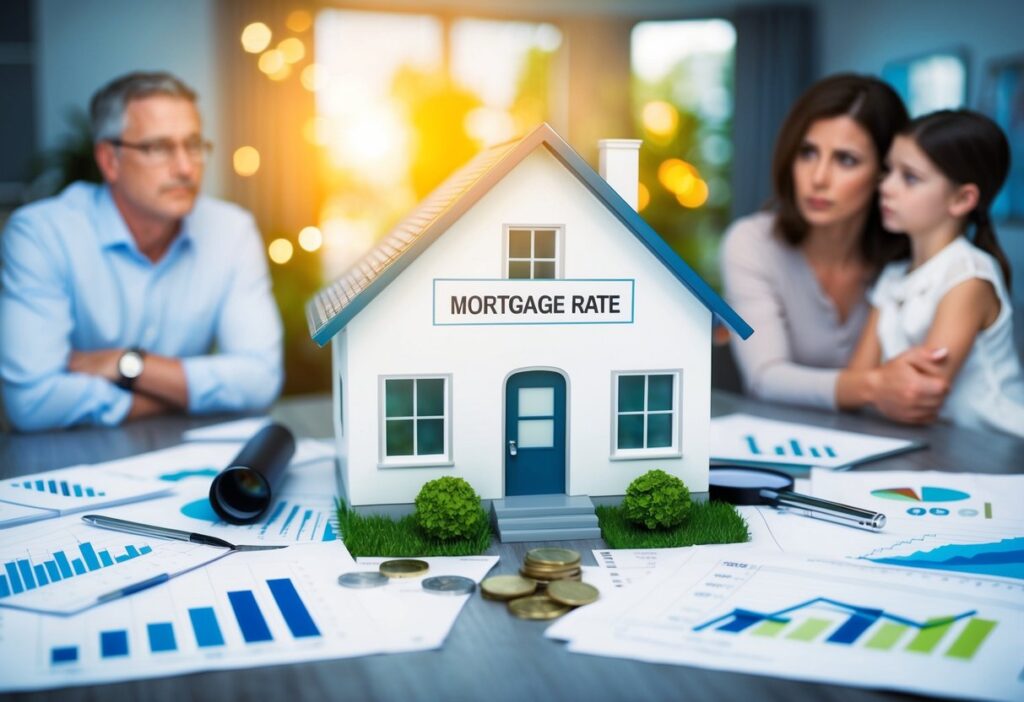Anúncios
Interest rates are on the rise again, and this shift has significant implications for anyone looking to buy a home or refinance an existing mortgage. Higher rates mean higher monthly payments, which can affect how much house you can afford.

When interest rates increase by just one percentage point, your borrowing power can decrease by approximately 10%. This means if you could afford a $300,000 home last year, you might only qualify for a $270,000 home today with the same income.
These changes don’t mean homeownership is out of reach, but they do require different strategies. Adjustable-rate mortgages, larger down payments, and extended loan terms are becoming more popular options as buyers adapt to the new lending environment.
Understanding Interest Rates and Mortgages

Interest rates affect almost every aspect of home loans, from monthly payments to total costs over time. The relationship between these rates and mortgage options directly impacts your buying power and financial strategy.
Basics of Interest Rates
Interest rates represent the cost of borrowing money from a lender. For mortgages, this rate determines how much you’ll pay beyond the principal loan amount.
Rates can be fixed (staying the same throughout the loan) or variable (changing over time). Fixed rates provide stability, while variable rates may start lower but carry future risk.
When rates increase by just 1%, a $300,000 mortgage can cost approximately $55,000 more over 30 years. This significant difference highlights why rate changes matter so much to homebuyers.
The annual percentage rate (APR) includes both the interest rate and other loan costs, providing a more complete picture of total loan expenses.
Types of Mortgages
Fixed-rate mortgages maintain the same interest rate for the entire loan term. Common periods include 15, 20, and 30 years. These loans provide predictable payments but typically start with higher rates than adjustable options.
Adjustable-rate mortgages (ARMs) feature rates that change after an initial fixed period. A 5/1 ARM, for example, keeps the same rate for five years before adjusting annually.
Interest-only mortgages allow borrowers to pay just the interest for an initial period, resulting in lower payments at first but higher payments later.
Government-backed loans include FHA, VA, and USDA options with different qualification requirements and sometimes lower rates for eligible borrowers.
Role of Central Banks
The Federal Reserve significantly influences mortgage rates through its monetary policy decisions. When the Fed raises its federal funds rate, mortgage rates typically follow suit.
Central banks adjust rates to manage inflation and economic growth. Higher rates help cool an overheated economy but make borrowing more expensive for homebuyers.
Banks and lenders determine specific mortgage rates based on the federal funds rate plus additional factors like:
- Credit market conditions
- Inflation expectations
- Treasury bond yields
- Housing market trends
The yield curve (the difference between short-term and long-term interest rates) often predicts future rate movements. An inverted yield curve may signal economic uncertainty ahead.
Effects of Rising Interest Rates

When interest rates climb, they create a ripple effect throughout the mortgage market. These changes affect both new homebuyers and existing homeowners in several important financial ways.
Increased Monthly Payments
Rising interest rates directly increase monthly mortgage payments. For example, a $300,000 30-year fixed-rate mortgage at 4% requires a payment of about $1,432 per month for principal and interest. The same loan at 6% jumps to $1,799 monthly.
This $367 monthly difference adds up to $4,404 per year in additional costs. For many households, this represents a significant portion of their annual budget.
First-time homebuyers often feel this impact most severely. They typically operate with tighter budgets and have less financial flexibility than established homeowners.
Fixed-rate mortgage holders remain protected from these increases. Their rates stay locked regardless of market changes. However, adjustable-rate mortgage holders face payment increases when their adjustment periods arrive.
Higher Total Loan Cost
The long-term impact of higher interest rates is substantial. A 2% rate increase on a $300,000 mortgage results in approximately $132,000 in additional interest paid over a 30-year term.
This extra cost reduces the financial benefits of homeownership. The money spent on interest might otherwise go toward:
- Retirement savings
- Education funds
- Home improvements
- Other investments
Lenders earn more from higher-rate loans, while borrowers build equity more slowly during the early years. This occurs because a larger portion of each payment goes toward interest rather than principal.
Some buyers respond by choosing shorter loan terms. While 15-year mortgages have higher monthly payments, they accumulate less total interest over time.
Pressure on Affordability
Rising rates shrink buying power significantly. For each 1% increase in mortgage rates, purchasing power typically decreases by about 10%.
Example of Reduced Buying Power:
| Interest Rate | Monthly Payment | Maximum Affordable Loan | Home Price Reduction |
|---|---|---|---|
| 4% | $1,900 | $400,000 | Baseline |
| 5% | $1,900 | $354,000 | -$46,000 |
| 6% | $1,900 | $316,000 | -$84,000 |
This reduction forces buyers to consider smaller homes, less desirable neighborhoods, or postponing purchases altogether. Housing markets in expensive regions feel these effects most acutely.
Higher rates also increase debt-to-income ratios, making loan approval more difficult. Lenders may require larger down payments to offset the increased lending risk.
Refinancing Challenges
When rates rise, refinancing opportunities diminish considerably. Homeowners who missed lower rates face a financial penalty if they need to refinance.
Refinancing makes financial sense only when new rates are significantly lower than existing ones. The general rule suggests refinancing when rates fall at least 0.75% to 1% below current mortgage rates.
Homeowners with adjustable-rate mortgages face difficult decisions when fixed rates rise. Converting to a fixed-rate loan provides stability but often at a higher rate than their initial terms.
Cash-out refinancing becomes more expensive in high-rate environments. This limits homeowners’ ability to tap equity for renovations, debt consolidation, or major expenses.
The refinance market typically contracts by 50-70% during rate increase cycles, creating staffing reductions in the mortgage industry.
Strategies for Managing Higher Rates

When interest rates climb, homebuyers need practical approaches to keep their mortgage costs manageable. Several effective strategies can help borrowers navigate this challenging environment and still secure favorable financing terms.
Fixed-Rate Versus Adjustable-Rate Mortgages
Fixed-rate mortgages offer stability with consistent payments throughout the loan term. During high interest periods, they protect borrowers from future rate increases.
Fixed-Rate Benefits:
- Predictable payments for easier budgeting
- Protection against future rate hikes
- Peace of mind knowing your rate won’t change
Adjustable-rate mortgages (ARMs) start with lower initial rates but can increase over time. These may work well if you plan to sell or refinance before the rate adjusts.
ARM Considerations:
- Initial savings with lower starting rates
- Potential for payments to increase significantly
- Best for short-term homeownership (5-7 years)
The fixed-rate option typically makes more sense when rates are expected to rise further. ARMs become more attractive when rates are projected to decrease.
Locking in Interest Rates
Rate locks guarantee your interest rate for a specific period, usually 30-60 days. This protects borrowers from rate increases during the loan processing timeline.
How Rate Locks Work:
- Lender agrees to honor today’s rate until closing
- Typically available for 30, 45, or 60 days
- Longer lock periods may cost extra
Timing is crucial when considering a rate lock. Monitor rate trends closely before making this decision.
Some lenders offer “float down” provisions that allow borrowers to secure lower rates if they drop during the lock period. This feature might come with additional fees but can provide valuable flexibility in uncertain markets.
Ask potential lenders about their specific lock policies and any associated costs before committing.
Down Payment Considerations
Larger down payments can significantly offset the impact of higher interest rates by reducing both the loan amount and potentially the rate itself.
Benefits of Larger Down Payments:
- Lower loan-to-value ratio may qualify for better rates
- Reduced principal means less interest paid over time
- May eliminate need for private mortgage insurance (PMI)
Aim for at least 20% down to avoid PMI, which adds 0.5-1% to your annual payment costs. However, don’t deplete emergency savings completely.
Government-backed loan programs offer alternatives with lower down payment requirements.
FHA loans require as little as 3.5% down, while VA and USDA loans may require no down payment for qualified borrowers.
Consider down payment assistance programs available through state and local housing agencies, especially for first-time homebuyers facing higher rate environments.